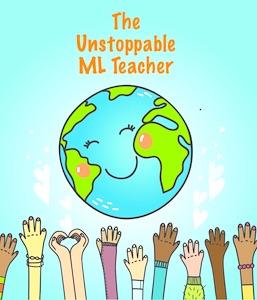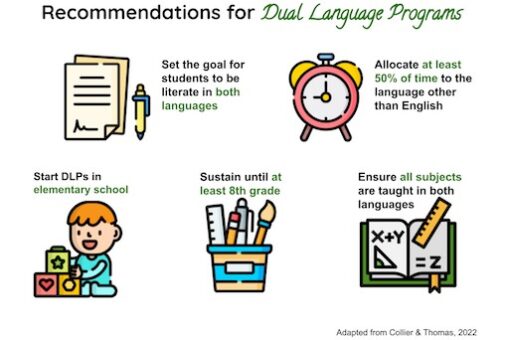Transform Learning with Dual Language Programs
A MiddleWeb Blog

I was curious about the interaction and asked, “Why didn’t you respond in Thai?” He said that English is his main language, and while he understands Thai, he prefers not to speak it as he is embarrassed by his lack of fluency.
I thought it was quite interesting that even though that student takes mandatory Thai language classes, lives in Thailand, and one of his parents is Thai, he only uses Thai with Thai people who can’t speak English.
Since language is anchored on culture, what cultural loss does this student experience as his English dominates? This student’s example is the lived experience of so many MLs. That’s because many schools offer another language only as a course instead of instituting a full dual language program.
Few scholars are more recognized than Dr. Virginia Collier and Dr. Wayne Thomas for their decades of work in studying and guiding districts to adopt dual language programs. In this article, I summarize the key ideas shared in my podcast conversation with these esteemed scholars.
The Case for Dual Language Programs
In Dr. Thomas’ largest data study to date (Thomas & Collier, 2012), he analyzed five years of test scores for every child enrolled in North Carolina’s public schools, totaling 1.1 million students. The results of the study suggested that:
► By eighth grade, students enrolled in dual language programs were 1 to 2 grades ahead compared to students not enrolled in dual language programs.
► These levels of achievement were also found in students from low socio-economic backgrounds and those enrolled in special education programs.
► 75% of the negative effects of poverty on student achievement were reduced for students enrolled in well-executed dual language programs.
► Students enrolled in dual language programs had increased attendance.
► Students who came from English-speaking families and enrolled in dual language programs significantly outperformed like peers who were not enrolled in these programs.
After Thomas shared the report with the governor’s office, the state decided to implement dual language programs in every district.
Reasons why dual language works
Dual language programs are effective for two main reasons:
1) engagement, and
2) cognitive development.
Multilingual students are more engaged in learning because they can comprehend the content through their heritage language. Instruction and content are presented in both languages, which raises their understanding of the topics. Greater understanding facilitates their participation in class, resulting in higher achievement
Additionally, in non-dual language programs, the multilingual learners (MLs) who are pulled out of their content classes learn less rigorous content to match their developing language competency. This results in an achievement gap as these students are not asked to perform more cognitively challenging tasks. Instead, they hover in a landing pattern over learning experiences that require students to only understand, identify, and recall.
In dual language programs, learning spans all of Bloom’s taxonomy, emphasizing applying, analyzing, evaluating and creating. This is possible because students already possess the linguistic skills in their heritage language required to do more cognitively demanding tasks.
Furthermore, students enrolled in dual language programs are able to learn more efficiently since they can access the content through a language they already understand. There’s less time wasted trying to figure out new content while simultaneously understanding it in a new language. In dual language programs, MLs are able to do more as they already have more in their first language.
Recommendations for effective dual language programs
► Start in elementary school.
► Sustain programs through at least 8th grade.
► Avoid transitional bilingualism (i.e., teaching in two languages with the goal of getting to mastery of the main language).
► Ensure that all subjects are taught in both languages.
► Adopt a two-way dual language program (i.e., teaching in two languages with the goal of the student being literate in both languages).
► Allocate at least 50% of the time to a language other than English (LOTE).
Dr. Thomas emphasizes that for the achievement gap to be fully closed for MLs, they require two-way dual language programs at least until 8th grade His recommendation comes from analyzing large data sets that reveal that when MLs receive anything else than a dual language learning experience, the most the achievement gap closes is by half.
Lastly, Dr. Collier shared that there are different models of dual language programs, such as:
► 50-50: half of the time to LOTE; half of the time to English.
► 80-20: eighty percent of the time to LOTE; twenty percent to English.
► 90-10: ninety percent of the time to LOTE; ten percent to English.
Her research suggests that elementary MLs enrolled in a 90-10 dual language program can reach grade level proficiency by the fifth grade. Conversely, it would take MLs until eighth grade to reach grade-level mastery in a 50-50 dual language model.
The 90-10 model forms the foundation for future cognitive learning in a new language while maintaining their first one. However, the 90-10 model is politically triggering for some school districts, so 50-50 can also work as it still propels students to grade-level proficiency in both languages by the 8th grade.
Closing
Intention and impact are different. Returning to my Thai student who prefers to speak English – was the impact of our good intentions worth the cost of losing his connection to his culture by nurturing one language over the other?
If we are to truly have culturally-sustaining and relevant pedagogy that expands students’ first language while strengthening their connection to their cultures, then dual language programs seem to be the best long-term path forward.
Reference
Thomas, W. P., & Collier, V. P. (2012). Dual language education for a transformed world. Dual Language Education of New Mexico.



































